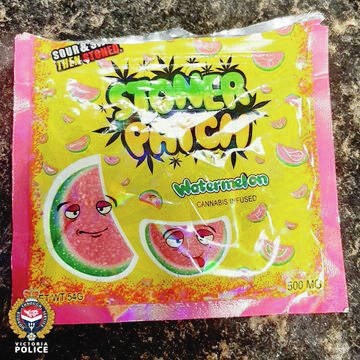Five children under the age of 10 were recently taken to Victoria General Hospital after eating cannabis-infused gummies they thought were candy. Their parents called 911 after they noticed the kids were behaving strangely.
This prompted Victoria police to warn parents who use cannabis products that these should be stored safely beyond the reach of children.
The gummies in question are sold in a package that bears every resemblance to a bag of candy. It’s brightly coloured, with smiling, human-faced watermelon slices scattered around.
If the makers were intending to appeal to children, they couldn’t have done better. Why on Earth is this kind of marketing permitted? The Tobacco and Vaping Products Act, introduced by the federal government in 2018, makes it illegal to allow “the sale of vaping products that appeal to youth.”
Shouldn’t the same rules apply to cannabis products? Unfortunately, they don’t.
Police have said they cannot lay charges because federal and provincial laws do not prohibit packaging that resembles non-cannabis products. This is plainly unacceptable.
The impression, obvious at the time, is that cannabis regulations were scrambled together with undue haste and lack of foresight.
The packaging resembles the kind of tobacco advertisements popular in the 1950s.
An ad for Camels showed a physician holding a package of the cigarettes, with the wording: “Give your throat a vacation … Smoke a FRESH cigarette.”
Chesterfields ran a spot with a smiling-faced young boy along side a package of their brand, the boy telling readers: “I remember Momma and Poppa! For Mother’s Day or Father’s Day. Any Day.”
A come-on for Marlboro cigarettes bore the face of a baby saying: “Gee Dad, you always get the best of everything, even Marlboro.”
Contrast these with the packaging now required of cigarette cartons. As of February 2020, plain packaging is required for all tobacco products, and rotating health warnings must occupy 75 per cent of the principal display areas.
These include warnings that smoking can cause oral cancer, cardiovascular disease, throat cancer and lung cancer, the latter complete with a photograph of an emaciated patient dying of the disease.
Now it can reasonably be argued that while smoking tobacco is clearly a major health risk, the evidence is not as strong, at any rate yet, with regard to consuming cannabis, especially in edible form.
There are also beneficial uses of cannabis, especially in the treatment of some types of epilepsy. The same cannot be said of cigarettes.
Nevertheless, there is a growing body of research that shows cannabis consumption is linked to psychiatric, cardiovascular and gastrointestinal symptoms. A new study out of Denmark found that the number of cases of schizophrenia associated with cannabis has increased fourfold in the past two decades.
A fair summary at this point would be to say that we do not yet know whether the health benefits associated with cannabis outweigh the risks. There has not been time to carry out the kind of long-term studies that would give us the answer.
Yet caution is needed. Any number of drugs originally thought beneficial were later found to be harmful. Thalidomide, once used by pregnant women to treat morning sickness, was discovered to be a cause of birth defects.
Bextra, a drug employed to treat arthritis, had to be withdrawn after patients taking it were shown to have far more strokes, heart attacks and blood clots than patients who did not receive the drug.
What can be said with certainty is that while we wait for more conclusive evidence one way or the other, under no circumstances should cannabis products be packaged in ways likely to attract children.
Both the federal government and the provinces should amend their regulations to end this unfortunate state of affairs. Anything less offers hostages to fortune, and the hostages in this case are our children.
- - -
To comment on this article, send a letter to the editor: [email protected]



